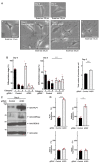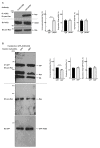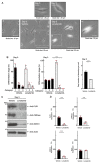CRISPR/CasRx-Mediated RNA Knockdown Reveals That ACE2 Is Involved in the Regulation of Oligodendroglial Cell Morphological Differentiation
- PMID: 35736639
- PMCID: PMC9229887
- DOI: 10.3390/ncrna8030042
CRISPR/CasRx-Mediated RNA Knockdown Reveals That ACE2 Is Involved in the Regulation of Oligodendroglial Cell Morphological Differentiation
Abstract
Angiotensin-converting enzyme 2 (ACE2) plays a role in catalyzing angiotensin II conversion to angiotensin (1-7), which often counteracts the renin-angiotensin system. ACE2 is expressed not only in the cells of peripheral tissues such as the heart and kidney, but also in those of the central nervous system (CNS). Additionally, ACE2 acts as the receptor required for the entry of severe acute respiratory syndrome coronavirus 2 (SARS-CoV-2), whose binding leads to endocytotic recycling and possible degradation of the ACE2 proteins themselves. One of the target cells for SARS-CoV-2 in the CNS is oligodendrocytes (oligodendroglial cells), which wrap neuronal axons with their differentiated plasma membranes called myelin membranes. Here, for the first time, we describe the role of ACE2 in FBD-102b cells, which are used as the differentiation models of oligodendroglial cells. Unexpectedly, RNA knockdown of ACE2 with CasRx-mediated gRNA or the cognate siRNA promoted oligodendroglial cell morphological differentiation with increased expression or phosphorylation levels of differentiation and/or myelin marker proteins, suggesting the negative role of ACE2 in morphological differentiation. Notably, ACE2's intracellular region preferentially interacted with the active GTP-bound form of Ras. Thus, knockdown of ACE2 relatively increased GTP-bound Ras in an affinity-precipitation assay. Indeed, inhibition of Ras resulted in decreasing both morphological differentiation and expression or phosphorylation levels of marker proteins, confirming the positive role of Ras in differentiation. These results indicate the role of ACE2 itself as a negative regulator of oligodendroglial cell morphological differentiation, newly adding ACE2 to the list of regulators of oligodendroglial morphogenesis as well as of Ras-binding proteins. These findings might help us to understand why SARS-CoV-2 causes pathological effects in the CNS.
Keywords: ACE2; Ras; differentiation; oligodendrocyte; oligodendroglial cell.
Conflict of interest statement
The authors declare no conflict of interest.
Figures








Similar articles
-
Knockdown of Rab7B, But Not of Rab7A, Which Antagonistically Regulates Oligodendroglial Cell Morphological Differentiation, Recovers Tunicamycin-Induced Defective Differentiation in FBD-102b Cells.J Mol Neurosci. 2023 Jun;73(6):363-374. doi: 10.1007/s12031-023-02117-y. Epub 2023 May 30. J Mol Neurosci. 2023. PMID: 37248316
-
Hyaluronic acid and its receptor CD44, acting through TMEM2, inhibit morphological differentiation in oligodendroglial cells.Biochem Biophys Res Commun. 2022 Oct 8;624:102-111. doi: 10.1016/j.bbrc.2022.07.092. Epub 2022 Jul 31. Biochem Biophys Res Commun. 2022. PMID: 35940122
-
Hesperetin, a Citrus Flavonoid, Ameliorates Inflammatory Cytokine-Mediated Inhibition of Oligodendroglial Cell Morphological Differentiation.Neurol Int. 2022 May 31;14(2):471-487. doi: 10.3390/neurolint14020039. Neurol Int. 2022. PMID: 35736620 Free PMC article.
-
Angiotensin-Converting Enzyme 2 (ACE2) in the Context of Respiratory Diseases and Its Importance in Severe Acute Respiratory Syndrome Coronavirus 2 (SARS-CoV-2) Infection.Pharmaceuticals (Basel). 2021 Aug 17;14(8):805. doi: 10.3390/ph14080805. Pharmaceuticals (Basel). 2021. PMID: 34451902 Free PMC article. Review.
-
Disequilibrium between the classic renin-angiotensin system and its opposing arm in SARS-CoV-2-related lung injury.Am J Physiol Lung Cell Mol Physiol. 2020 Aug 1;319(2):L325-L336. doi: 10.1152/ajplung.00189.2020. Epub 2020 Jul 8. Am J Physiol Lung Cell Mol Physiol. 2020. PMID: 32639866 Free PMC article. Review.
Cited by
-
Hypomyelinating Leukodystrophy 10 (HLD10)-Associated Mutations of PYCR2 Form Large Size Mitochondria, Inhibiting Oligodendroglial Cell Morphological Differentiation.Neurol Int. 2022 Dec 16;14(4):1062-1080. doi: 10.3390/neurolint14040085. Neurol Int. 2022. PMID: 36548190 Free PMC article.
-
Knockdown of Rab7B, But Not of Rab7A, Which Antagonistically Regulates Oligodendroglial Cell Morphological Differentiation, Recovers Tunicamycin-Induced Defective Differentiation in FBD-102b Cells.J Mol Neurosci. 2023 Jun;73(6):363-374. doi: 10.1007/s12031-023-02117-y. Epub 2023 May 30. J Mol Neurosci. 2023. PMID: 37248316
-
Investigating the Protective Effects of a Citrus Flavonoid on the Retardation Morphogenesis of the Oligodendroglia-like Cell Line by Rnd2 Knockdown.Neurol Int. 2023 Dec 26;16(1):33-61. doi: 10.3390/neurolint16010003. Neurol Int. 2023. PMID: 38251051 Free PMC article.
References
LinkOut - more resources
Full Text Sources
Miscellaneous

